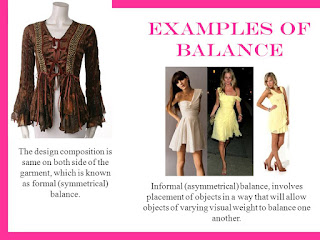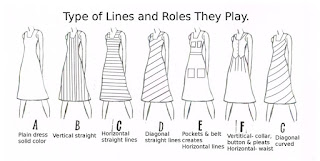principle of fashion designing
The principle of fashion design includes Harmony, Balance, Proportion, Emphasis, and Rhythm. Therefore, when it comes to fashion designing every designing has to smartly combine these principles and use them to enhance the look of a garment.
The principles of art represent how the artist uses the element of art to create an effect.there are five principles of fashion designing. there are 5 important principles to take into consideration which are:............
1- Balance
2-rhythm and repetition
3-emphasis
4-proportion and scale
5-harmony
that the parts or features of a garment have equal visual weight. Whether the element is a sleeve, a cuff, or a line of buttons, it works with the other parts of a garment.
Harmony
is the harmony between all the principles. Unity refers to the overall look in a garment. For example, take a blue skirt detailing like a pocket. Here unity would refer to the color, size, and detail which create a sense of harmony. At a glance, the skirt appears complete.
Assignment- Draw Free Hand Lines & Shapes.
The principles of art represent how the artist uses the element of art to create an effect.there are five principles of fashion designing. there are 5 important principles to take into consideration which are:............
1- Balance
2-rhythm and repetition
3-emphasis
4-proportion and scale
5-harmony
every designer has to smartly combine these principles and use them to enhance the look of a garment. For example, the actual beauty of the dress comes out only when it has beautiful work, eye-catching color, perfect pattern, etc. All these elements can be achieved only when these principles are applied in a creative manner.
Let us understand each of these principles in detail:
Balancethat the parts or features of a garment have equal visual weight. Whether the element is a sleeve, a cuff, or a line of buttons, it works with the other parts of a garment.
Balance is another important principle of design. Balance again can be split into two- symmetrical and asymmetrical balance. Symmetrical balance is when you divide a garment horizontally or vertically, it appears the same. On the other hand, asymmetrical balance can be defined when a garment has unequal sides or does not appear the same.
Most designers apply asymmetrical balance on formal clothing such as evening gowns. This style adds a chic look and lots of drama to the attire.
In popular fashion designing institutes such as Hamstech, students get to showcase their collections on the ramp. As they prepare for the big event, they are closely monitored and mentored by experts on how to apply these principles creatively in each of their collections
.Rhythm and Repetition
The smooth flow of lines, texture, color, shape, pattern, etc. in a garment is referred to as rhythm. When you take a look at a garment that has horizontal or vertical lines artistically arranged, it creates a flow. Similarly, this principle can be applied to color, print, etc.
Very often people face problems when it comes to dressing. You can take advantage of these principles in your daily styling.
These principles when applied smartly, can enhance the look of a person. For example, a petite woman must choose garments that are proportionate to her height and weight. She must avoid wearing garments that are loose as they appear unflattering. Instead, she must choose patterns and designs that balance her upper and lower body. Similarly, a woman with a heavy upper body must avoid garments that lay emphasis on the shoulder, bust or neckline. Emphasis like a heavy embroidery or a design would make her look heavier. She can choose tiny prints or dark colors that take the attention away from her upper body.
As you get to understand each of these principles, you’ll enjoy designing every element of a garment. As a fun assignment, you can do a quick run through your own closet. You’ll be amazed to know how well you can identify the principles.
Emphasis
Emphasis refers to one particular element in a garment that is exaggerated. An example here would be an evening gown that has a huge flower or a bow on it. Here, the prominent element is the huge flower or bow which is emphasized on the gown. This is something that stands out from the rest of the elements used in the gown. This element instantly grabs your attention.
Proportion and scale
Proportion is one of the most important principles of design, especially when applied to a garment. It relates to different elements of a garment such as a number, size, and amount. For example, in fashion design classes, students are taught to sketch a body form keeping various body proportions in mind. The measurement of the head is small as compared to other parts of the body. Similarly, this concept is applied when designing a garment. Elements such as a collar, pocket, placket, hemline, etc. are designed in such a way that it is proportionate to one another.
Harmony
is the harmony between all the principles. Unity refers to the overall look in a garment. For example, take a blue skirt detailing like a pocket. Here unity would refer to the color, size, and detail which create a sense of harmony. At a glance, the skirt appears complete.
Assignment- Draw Free Hand Lines & Shapes.











Mam ... principle bhut acche s samj m n aa rahe h... Aap ek baar aur video banyie,, plzz
ReplyDeleteI give praise to Mr Benjamin enough for his help in securing a loan to buy our new home for our family. Benjamin was a wealth of information and he helped educate me and my family as to why a home loan was the best option for our particular situation. After conferring with Benjamin and our financial advisor everyone agreed that a home loan was the perfect solution.You can contact Mr Benjamin if you also looking for any kind of loan on Email/Whatsappemail: 247officedept@gmail.com Whatsapp: +1-989-394-3740
ReplyDeletemam mn apni assignment kaise submit karon? mn new student hn. m apki classes le rhi h. kya mjy b certificate mile ga. mjy zarorat b h.
ReplyDelete